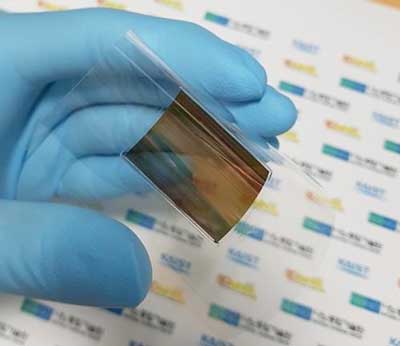| Posted: Sep 17, 2018 | |
Researchers perfectly transfer nanowires onto a flexible substrate(Nanowerk News) Boasting excellent physical and chemical properties, nanowires (NWs) are suitable for fabricating flexible electronics; therefore, technology to transfer well-aligned wires plays a crucial role in enhancing performance of the devices. |
|
| A Korea Advanced Institute of Science and Technology (KAIST) research team succeeded in developing nanowire-transfer technology that is expected to enhance the existing chemical reaction-based NW fabrication technology that has this far showed low performance in applicability and productivity (ACS Nano, "Material-Independent Nanotransfer onto a Flexible Substrate Using Mechanical-Interlocking Structure"). | |
 |
|
| Photograph of the fabricated wafer-scale fully aligned and ultralong Au nanowire array on a flexible substrate. (Image: KAIST) | |
| Nanowire, one of the most well-known nanomaterials, have the structural advantage of being small and lightweight. Hence, nanowire-transfer technology has drawn attention because it can fabricate high-performance, flexible nanodevices with high simplicity and throughput. | |
|
A conventional nanowire-fabrication method |
|
| Hence, numerous nanofabrication processes have emerged, and one of them is master-mold-based, which enables the fabrication of highly ordered NW arrays embedded onto substrates in a simple and cost-effective manner, but its employment is limited to only some materials because of its chemistry-based NW-transfer mechanism, which is complex and time consuming. For the successful transfer, it requires that adequate chemicals controlling the chemical interfacial adhesion between the master mold, nanowires, and flexible substrate be present. | |
| Here, Professor Jun-Bo Yoon and his team from the School of Electrical Engineering introduced a material-independent mechanical-interlocking-based nanowire-transfer (MINT) method to fabricate ultralong and fully aligned NWs on a large flexible substrate in a highly robust manner. | |
| This method involves sequentially forming a nanosacrificial layer and NWs on a nanograting substrate that becomes the master mold for the transfer, then weakening the structure of the nanosacrificial layer through a dry etching process. The nanosacrificial layer very weakly holds the nanowires on the master mold. Therefore, when using a flexible substrate material, the nanowires are very easily transferred from the master mold to the substrate, just like a piece of tape lifting dust off a carpet. | |
| This technology uses common physical vapor deposition and does not rely on NW materials, making it easy to fabricate NWs onto the flexible substrates. | |
| Using this technology, the team was able to fabricate a variety of metal and metal-oxide NWs, including gold, platinum, and copper – all perfectly aligned on a flexible substrate. They also confirmed that it can be applied to creating stable and applicable devices in everyday life by successfully applying it to flexible heaters and gas sensors. | |
| PhD Min-Ho Seo who led this research said, “We have successfully aligned various metals and semiconductor NWs with excellent physical properties onto flexible substrates and applied them to fabricated devices. As a platform-technology, it will contribute to developing high-performing and stable electronic devices.” |
| Source: Korea Advanced Institute of Science and Technology | |
|
Subscribe to a free copy of one of our daily Nanowerk Newsletter Email Digests with a compilation of all of the day's news. |
